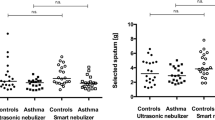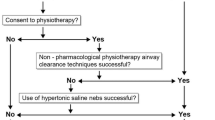Abstract
Purpose
To investigate inflammatory changes in the induced sputum (IS) of gas station attendants (GSAs) at risk of exposure to fuel vapors through inhalation and susceptible to respiratory complaints and impaired lung function.
Methods
Hypertonic saline-IS was collected from 52 GSAs who had never smoked (42 men, age = 35.9 ± 8.9 years) and had no known comorbidities. A group of 22 non-smokers (11 men, age = 30.5 ± 5.1 years) selected from the University staff served as control. The GSAs answered a questionnaire and underwent spirometry and chest tomography. A total of 15 inflammatory biomarkers associated with inflammation, including cytokines, chemokines, and mediators of immunological response, were also measured.
Results
The most common symptoms of GSAs were coughing (42.3%) and dyspnea (59.6%) based on the New York Heart Association (NYHA; Class II) classification. Significant elevations (p < 0.05) in forced vital capacity and forced expiratory volume within the first second were observed in the GSAs relative to those in the controls (GSA vs. control: 99 ± 12% vs. 90 ± 9% and 94 ± 11% vs. 87 ± 10%, respectively). The GSAs had a lower percentage of IS lymphocytes than that in the control group (4.5 ± 5.7% vs. 7.7 ± 9.8%). The GSAs also had significantly lower concentrations of IL-4, IL-5, IL-10, IL-12P70, IFN-γ, and MIP-1α, but IL-3 levels were higher. No differences were observed in the airway thickness and the amount of emphysema between the GSAs and the controls.
Conclusion
Despite normal lung function and absence of abnormalities on HRCT, GSAs have a higher frequency of respiratory complaints, with evidence of impairment of lymphocytic activity in the airways.

Similar content being viewed by others
Availability of data and material
Requests to access the data set from qualified researchers may be sent to the corresponding author.
References
Abou-El Wafa HS, Albadry AA, El-Gilany AH, Bazeed FB (2015) Some biochemical and hematological parameters among petrol station attendants: a comparative study. Biomed Res Int 2015:418724. https://doi.org/10.1155/2015/418724
Adeniyi BO (2014) Pulmonary function and symptoms among petrol pump attendants in Nigeria. Int J Biol Med Res 5(1):3780–3784
Ahmadi Z, Moradabadi A, Abdollahdokht D, Mehrabani M, Nematollahi MH (2019) Association of environmental exposure with hematological and oxidative stress alteration in gasoline station attendants. Environ Sci Pollut Res Int 26(20):20411–20417. https://doi.org/10.1007/s11356-019-05412-7
Aprajita PNK, Sharma RS (2011) A study on the lung function tests in petrol-pump workers. J Clin Diag Res 5(5):1046–1050
Chen R, Lowe L, Wilson JD, Crowther E, Tzeggai K, Bishop JE, Varro E (1999) Simultaneous quantification of six human cytokines in a single sample using microparticle-based flow cytometric technology. Clin Chem 45(9):1693–1694
Cook EB, Stahl JL, Lowe L, Chen R, Morgan E, Wilson J, Varro R et al (2001) Simultaneous measurement of six cytokines in a single sample of human tears using microparticle-based flow cytometry: allergics vs. non-allergics. J Immunol Methods 254(1–2):109–118. https://doi.org/10.1016/s0022-1759(01)00407-0
Davidson WJ, The S, Leigh R (2013) Establishing a normal range for induced sputum cell counts in Western Canada. Can Respir J 20(6):424–425. https://doi.org/10.1155/2013/547309
Dissi GM, Sulaiman I, Mabrouk MA, Yarube IU, Salisu AI, El-ta’al AB, Muhammad S, et al (2017) Assessment of lung function and respiratory symptoms among petrol hawkers in Kano metropolis. BJMLS 2(1):164–170
Dougan M, Dranoff G, Dougan SK (2019) GM-CSF, IL-3, and IL-5 family of cytokines: regulators of inflammation. Immunity 50(4):796–811. https://doi.org/10.1016/j.immuni.2019.03.022
Edokpolo B, Yu QJ, Connell D (2014) Health risk assessment of ambient air concentrations of benzene, toluene and xylene (BTX) in service station environments. Int J Environ Res Public Health 11(6):6354–6374. https://doi.org/10.3390/ijerph110606354
Gee K, Guzzo C, Che Mat NF, Ma W, Kumar A (2009) The IL-12 family of cytokines in infection, inflammation and autoimmune disorders. Inflamm Allergy Drug Targets 8(1):40–52. https://doi.org/10.2174/187152809787582507
Getu S, Shiferaw E, Melku M (2020) Assessment of hematological parameters of petrol filling workers at petrol stations in Gondar town, Northwest Ethiopia: a comparative cross-sectional study. Environ Health Prev Med 25(1):44. https://doi.org/10.1186/s12199-020-00886-1
Jakobsson R, Ahlbom A, Bellander T, Lundberg I (1993) Acute myeloid leukemia among petrol station attendants. Arch Environ Health 48(4):255–259. https://doi.org/10.1080/00039896.1993.9940369
Jiménez-Garza O, Guo L, Byun HM, Carrieri M, Bartolucci GB, Barrón-Vivanco BS, Baccarelli AA (2018) Aberrant promoter methylation in genes related to hematopoietic malignancy in workers exposed to a VOC mixture. Toxicol Appl Pharmacol 339:65–72. https://doi.org/10.1016/j.taap.2017.12.002
Lachmann N, Ackermann M, Frenzel E, Liebhaber S, Brennig S, Happle C, Hoffmann D et al (2015) Large-scale hematopoietic differentiation of human induced pluripotent stem cells provides granulocytes or macrophages for cell replacement therapies. Stem Cell Reports 4(2):282–296. https://doi.org/10.1016/j.stemcr.2015.01.005
Laidlaw BJ, Craft JE, Kaech SM (2016) The multifaceted role of CD4(+) T cells in CD8(+) T cell memory. Nat Rev Immunol 16(2):102–111. https://doi.org/10.1038/nri.2015.10
Lan Q, Zhang L, Li G, Vermeulen R, Weinberg RS, Dosemeci M, Rappaport SM et al (2004) Hematotoxicity in workers exposed to low levels of benzene. Science 306(5702):1774–1776. https://doi.org/10.1126/science.1102443
Li CY, Sung FC (1999) A review of the healthy worker effect in occupational epidemiology. Occup Med (lond) 49(4):225–229. https://doi.org/10.1093/occmed/49.4.225
Lim HJ, Weinheimer O, Wielpütz MO, Dinkel J, Hielscher T, Gompelmann D, Kauczor HU et al (2016) Fully automated pulmonary lobar segmentation: influence of different prototype software programs onto quantitative evaluation of chronic obstructive lung disease. PLoS ONE 11(3):e0151498. https://doi.org/10.1371/journal.pone.0151498
Maciel LA, Feitosa SB, Trolly TS, Sousa AL (2020) Genotoxic effects of occupational exposure among gas station attendants in Santarem, Para, Brazil. Rev Bras Med Trab 17(2):247–253. https://doi.org/10.5327/Z1679443520190382
Martinez-Valenzuela C, Soto FB, Waliszewski SM, Meza E, Arroyo SG, Martínez LDO, Meraz EA et al (2017) Induced cytotoxic damage by exposure to gasoline vapors: a study in Sinaloa, Mexico. Environ Sci Pollut Res Int 24(1):539–546. https://doi.org/10.1007/s11356-016-7821-8
Maurer M, von Stebut E (2004) Macrophage inflammatory protein-1. Int J Biochem Cell Biol 36(10):1882–1886. https://doi.org/10.1016/j.biocel.2003.10.019
Moghadam SR, Afshari M, Moosazadeh M, Khanjani N, Ganjali A (2019) The effect of occupational exposure to petrol on pulmonary function parameters: a review and meta-analysis. Rev Environ Health 34(4):377–390. https://doi.org/10.1515/reveh-2019-0048
Moghadam SR, Afshari M, Ganjali A, Moosazadeh M (2020) Effect of occupational exposure to petrol and gasoline components on liver and renal biochemical parameters among gas station attendants, a review and meta-analysis. Rev Environ Health 35(4):517–530. https://doi.org/10.1515/reveh-2019-0107
Moolla R, Curtis CJ, Knight J (2015) Occupational exposure of diesel station workers to BTEX compounds at a bus depot. Int J Environ Res Public Health 12(4):4101–4115. https://doi.org/10.3390/ijerph120404101
Moro AM, Brucker N, Charão MF et al (2015) Early hematological and immunological alterations in gasoline station attendants exposed to benzene. Environ Res 137:349–356. https://doi.org/10.1016/j.envres.2014.11.003
Moro AM, Brucker N, Charão MF, Sauer E, Freitas F, Durgante J, Bubols G et al (2019) Evaluation of immunological, inflammatory, and oxidative stress biomarkers in gasoline station attendants. BMC Pharmacol Toxicol 20(Suppl 1):75. https://doi.org/10.1186/s40360-019-0355-1
Nicholas B, Djukanović R (2009) Induced sputum: a window to lung pathology. Biochem Soc Trans 37(Pt 4):868–872. https://doi.org/10.1042/BST0370868
Oesch F, Fuchs J, Vaupel J, Hengstler JG (1995) DNA single strand break analysis in mononuclear blood cells of petrol pump attendants. Int Arch Occup Environ Health 67(1):35–39. https://doi.org/10.1007/BF00383130
Okemuo AJ, Ominyi L, Ojukwu CP, Uchenwoke CI, Chukwu CS, Ezugw UA (2020) Assessment of respiratory symptoms and cardiopulmonary indices among petrol pump attendants in Enugu Metropolis. Int J Med Health Dev 25:106–111
Oni TM, Ana GREE (2019) Ambient air pollution exposure and lung function assessment of filling station attendants in Ibadan. Nigeria Rev Environ Health 34(2):211–218. https://doi.org/10.1515/reveh-2018-0027
Pereira CA, Sato T, Rodrigues SC (2007) New reference values for forced spirometry in white adults in Brazil. J Bras Pneumol 33(4):397–406. https://doi.org/10.1590/S1806-37132007000400008
Scheepers PTJ, de Werdt L, van Dael M, Anzion R, Vanoirbeek J, Duca RC, Creta M et al (2019) Assessment of exposure of gas station attendants in Sri Lanka to benzene, toluene and xylenes. Environ Res 178:108670. https://doi.org/10.1016/j.envres.2019.108670
Scheicher ME, Terra Filho J, Vianna EO (2003) Sputum induction: review of literature and proposal for a protocol. Sao Paulo Med J 121(5):213–219. https://doi.org/10.1590/s1516-31802003000500008
Shah D (2009) Healthy worker effect phenomenon. Indian J Occup Environ Med 13(2):77–79. https://doi.org/10.4103/0019-5278.55123
Sociedade Brasileira de Pneumologia e Tisiologia (2002) Diretrizes para testes de função pulmonar. J Pneumol 28(Suppl 3):S1–S82
Solanki RB, Bhise AR, Dangi BM (2015) A study on spirometry in petrol pump workers of Ahmedabad. India Lung India 32(4):347–352. https://doi.org/10.4103/0970-2113.159567
Spanevello A, Confalonieri M, Sulotto F, Romano F, Balzano G, Migliori GB, Bianchi A et al (2000) Induced sputum cellularity. Reference values and distribution in normal volunteers. Am J Respir Crit Care Med 162(3 Pt 1):1172–1174. https://doi.org/10.1164/ajrccm.162.3.9908057
Wada DT, de Almeida FA, de Moraes DA, Dias JBE, Baddini-Martinez J, Oliveira MC, Koenigkam-Santos M (2020) Automatic quantitative computed tomography evaluation of the lungs in patients with systemic sclerosis treated with autologous stem cell transplantation. J Clin Rheumatol 26:S158–S164. https://doi.org/10.1097/RHU.0000000000001242 (PMID: 31868835)
Yampara Guarachi GI, Barbosa Moreira V, Santos Ferreira A, Sias SM, Rodrigues CC, Teixeira GH (2014) Lipoid pneumonia in a gas station attendant. Case Rep Pulmonol 2014:358761. https://doi.org/10.1155/2014/358761
Funding
This study was supported by the Fundação de Amparo a Pesquisa do Estado de São Paulo (FAPESP), Grant # 2016/10685-9.
Author information
Authors and Affiliations
Contributions
THGS: conception and data collection; ACG: pulmonary function studies; MKS: radiological studies; BSM: biochemical tests; JBM: conception of the study, statistical analysis and wrote the manuscript.
Corresponding author
Ethics declarations
Conflict of interest
The authors report no conflicts of interest.
Ethical approval
Ethical approval by the local Institutional Review Boarding.
Consent to participate
All participants provided written informed consent.
Consent for publication
All authors agreed with publication.
Additional information
Publisher's Note
Springer Nature remains neutral with regard to jurisdictional claims in published maps and institutional affiliations.
Rights and permissions
About this article
Cite this article
da Silva, T.H.G., Gastaldi, A.C., Santos, M.K. et al. Induced sputum abnormalities in gas station attendants. Int Arch Occup Environ Health 95, 341–349 (2022). https://doi.org/10.1007/s00420-021-01755-2
Received:
Accepted:
Published:
Issue Date:
DOI: https://doi.org/10.1007/s00420-021-01755-2




